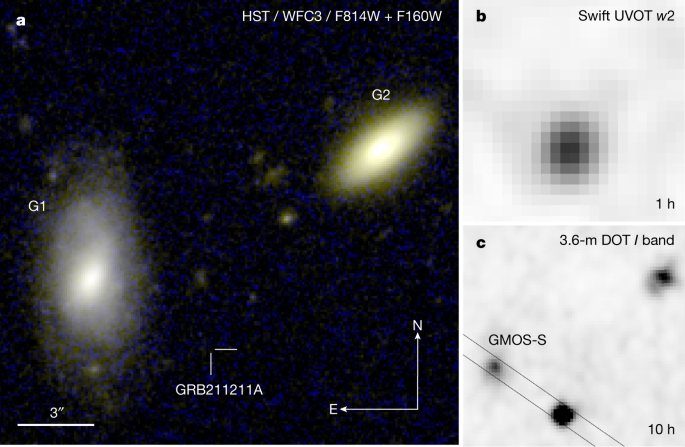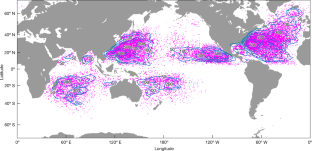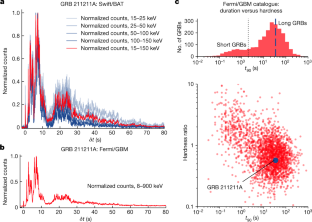超新星の起源に疑問を投げかけるモデリングにより、ガンマ線バースト現象の一般的な見解に再考を迫られる Modeling calls into question supernova origin, forcing reconsideration of the prevailing view of gamma-ray-burst events
2022-12-08 ロスアラモス国立研究所(LANL)
2021年12月11日、いくつかの天文台や衛星が、非常に明るい50秒間のガンマ線バーストと、それに伴う光学、赤外線、X線放射を記録した。この長いバーストは比較的近くにあり、天の川銀河とは別の銀河で約10億光年離れていたが、その放射特性は長いバースト事象のプロファイルに適合しなかった。その結果、コンパクトな天体が合体して、キロノバを発生させながら長時間のガンマ線バーストを放出するという、これまで観測されていなかったハイブリッド事象が起きていることが分かった。
モデリングチームは、この観測結果を超新星やキロノバのシミュレーションと比較しましたが、超新星モデルには納得のいく信号が得られず、一方キロノバモデルには、光学データや赤外線データのポイントとよく一致するものがいくつかあった。
この検出は、ガンマ線バーストに関する我々の標準的な考えを覆すもので、もはや、すべての短時間バーストが中性子星の合体から、長時間バーストが超新星から来ると仮定することはできません。ガンマ線バーストは分類が非常に難しい。今回の検出は、ガンマ線バーストに対する我々の理解を限界まで押し上げるものである。
<関連情報>
- https://discover.lanl.gov/news/1207-gamma-ray-burst
- https://www.nature.com/articles/s41586-022-05327-3
コンパクト天体の合体による近接型長尺ガンマ線バースト A nearby long gamma-ray burst from a merger of compact objects
E. Troja,C. L. Fryer,B. O’Connor,G. Ryan,S. Dichiara,A. Kumar,N. Ito,R. Gupta,R. T. Wollaeger,J. P. Norris,N. Kawai,N. R. Butler,A. Aryan,K. Misra,R. Hosokawa,K. L. Murata,M. Niwano,S. B. Pandey,A. Kutyrev,H. J. van Eerten,E. A. Chase,Y.-D. Hu,M. D. Caballero-Garcia & A. J. Castro-Tirado
Nature Published:07 December 2022
DOI:https://doi.org/10.1038/s41586-022-05327-3

Abstract
Gamma-ray bursts (GRBs) are flashes of high-energy radiation arising from energetic cosmic explosions. Bursts of long (greater than two seconds) duration are produced by the core-collapse of massive stars1, and those of short (less than two seconds) duration by the merger of compact objects, such as two neutron stars2. A third class of events with hybrid high-energy properties was identified3, but never conclusively linked to a stellar progenitor. The lack of bright supernovae rules out typical core-collapse explosions4,5,6, but their distance scales prevent sensitive searches for direct signatures of a progenitor system. Only tentative evidence for a kilonova has been presented7,8. Here we report observations of the exceptionally bright GRB 211211A, which classify it as a hybrid event and constrain its distance scale to only 346 megaparsecs. Our measurements indicate that its lower-energy (from ultraviolet to near-infrared) counterpart is powered by a luminous (approximately 1042 erg per second) kilonova possibly formed in the ejecta of a compact object merger.



